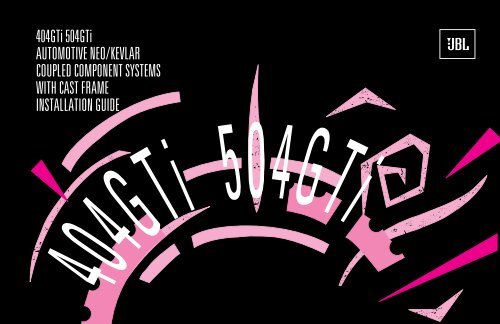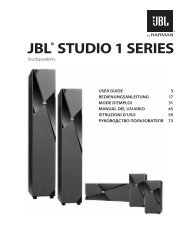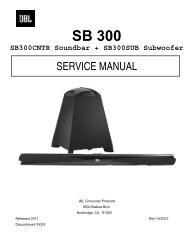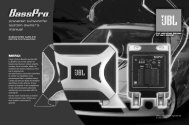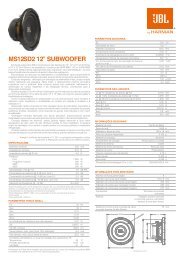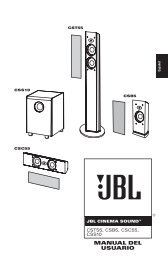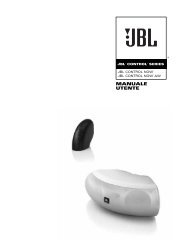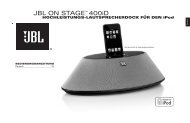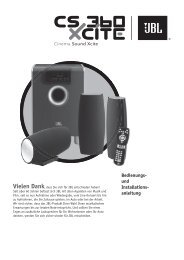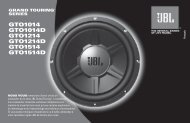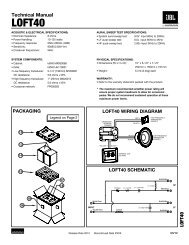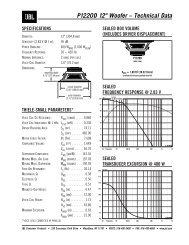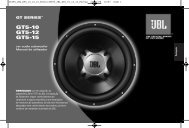404 GTI - JBL
404 GTI - JBL
404 GTI - JBL
Create successful ePaper yourself
Turn your PDF publications into a flip-book with our unique Google optimized e-Paper software.
Table of Contents<br />
Welcome to Club GTi ............................................3<br />
About this Manual .................................................3<br />
Autosound at its Best ............................................3<br />
Designing Your System .........................................5<br />
Coupled Component TM Placement.........................5<br />
Installation Warnings and Tips ..............................6<br />
Mounting Instructions ............................................6<br />
Installing the GTi System Crossover .....................6<br />
Woofer/Midrange Driver Mounting ........................7<br />
Mounting Speakers in Custom Locations..............8<br />
Wiring ..................................................................10<br />
System Connections ...........................................10<br />
Crossover Tweeter Level Adjustment..................12<br />
Speaker Break-In ................................................12<br />
A Note on Power Handling ..................................12<br />
In Case of Difficulty .............................................13<br />
Specifications ......................................................14<br />
Thiele-Small Specifications .................................15<br />
2
Welcome to Club GTi<br />
Thank you for purchasing the finest<br />
Automotive Coupled Component TM<br />
Systems <strong>JBL</strong> has ever produced. As a<br />
GTi Competition Series owner, you are a<br />
member of a select group of people who<br />
enjoy the most advanced mobile audio<br />
products available. We call this group<br />
“Club GTi.” By sending in the customer<br />
information card, which you will find<br />
attached to your warranty, we will<br />
automatically register you as a Club GTi<br />
member which will give you access to<br />
exclusive Club GTi apparel and other<br />
special offers we will make available from<br />
time to time. We suggest you fill the card<br />
out at your earliest convenience.<br />
Also, be sure to save your sales<br />
receipt in a safe place. It will be necessary<br />
to use this document as proof of purchase<br />
in the event that you ever need warranty<br />
service. It is also useful for insurance<br />
purposes and for establishing value when<br />
you re-sell your vehicle.<br />
About This Manual<br />
Because of the performance capability<br />
of your GTi Competition Series product,<br />
and the variety of potential system<br />
configurations, we strongly recommend<br />
that you have the system professionally<br />
installed. You will also get a better warranty<br />
if your equipment is professionally installed<br />
by an authorized GTi dealer and you have<br />
your warranty card stamped. This manual<br />
provides information on installation and<br />
usage to help a skilled technician get the<br />
most from your GTi Competition Series<br />
product. This manual does not cover basic<br />
information about installation which is<br />
common knowledge to a professional<br />
installer, except for information which is<br />
unique to the <strong>404</strong> and 504GTi systems.<br />
If you feel you possess the necessary<br />
skills, and prefer to install the equipment<br />
yourself, this manual will provide you with<br />
the necessary specifics to properly use the<br />
<strong>404</strong> or 504GTi in typical installations.<br />
Consult your <strong>JBL</strong> dealer, or a qualified<br />
technician, for more information.<br />
Autosound at its Best<br />
The <strong>404</strong> and 504GTi Coupled<br />
Components TM are built to meet the same<br />
rigorous standards of construction and<br />
performance that have long established<br />
<strong>JBL</strong>’s renowned home and professional<br />
speaker systems. Coupled Components TM<br />
are the first to provide true component<br />
driver quality in a format which mounts<br />
in a single hole. The GTi Coupled<br />
Components TM combine the reference<br />
standard 400 and 500GTi Woofer/Midrange<br />
Drivers with a cantilever mounted 20mm<br />
Pure Titanium tweeter and outboard<br />
2-way crossover. The tweeter is mounted<br />
at a 15° angle which, combined with the<br />
exclusive Intermount TM mounting system,<br />
allows orientation of the speaker for<br />
optimum imaging in any vehicle. The<br />
near-coincident mounting provides the<br />
considerable advantages of equal soundpath<br />
length from the woofer and tweeter to<br />
your ear, but without the horn loading<br />
effects that create a distorted midrange in<br />
designs with apex-mounted tweeters.<br />
3
The <strong>404</strong> and 504GTi Woofer/Midrange<br />
Drivers incorporate advanced <strong>JBL</strong> woven<br />
Kevlar cones which are especially suited<br />
to the unique acoustic and environmental<br />
conditions which characterize automotive<br />
sound. The 20mm tweeter incorporates<br />
advanced <strong>JBL</strong> pure titanium technology<br />
which works extremely well in the<br />
unique acoustic environment of modern<br />
vehicles. The <strong>404</strong> and 504GTi have been<br />
engineered to provide excellent power<br />
handling, good dispersion and balanced<br />
frequency response, along with minimum<br />
size and flexible installation options for<br />
optimizing placement within the vehicle.<br />
Treated Kevlar fiber cones are used<br />
because of their combination of low<br />
weight, high stiffness and resistance to<br />
resonances. The <strong>404</strong> and 504GTi<br />
Woofer/Midranges are topped off with a<br />
treated fabric inverted dome for smooth<br />
reproduction of upper midrange<br />
frequencies.<br />
The cone motion of these high<br />
excursion woofer/midrange designs is<br />
controlled by a Aromatic Polyamid fiber<br />
spider. Because it is 3 times stronger than<br />
4<br />
conventional spider materials, this robust<br />
material is able to control the up to 0.6"<br />
motion of the cone while maintaining<br />
musical accuracy.<br />
The small size of the GTi Woofer/<br />
Midrange Drivers is made possible<br />
through the use of a Neodymium magnet<br />
assembly with <strong>JBL</strong>’s Stray Field<br />
Containment Geometry. By minimizing<br />
stray magnetic fields, this closed circuit<br />
magnetic assembly design concentrates<br />
the magnetic field on the voice coil where<br />
it provides superior performance. In the<br />
woofer/midrange drivers, this high<br />
concentration of magnetic power is<br />
coupled to a 2" Edge-wound Aluminum<br />
Wire High Temperature Fiberglass Voice<br />
Coil. This coil uses lightweight aluminum<br />
wire to maintain the agility to reproduce<br />
high frequencies while its large diameter<br />
and fiberglass former assures extremely<br />
high thermal power handling. The tweeter<br />
uses Oxygen Free Copper wire immersed<br />
in a thermally conductive bath of viscous<br />
Ferrofluid TM . This fluid not only conducts<br />
heat away from the voice-coil to improve<br />
power handling, but damps the<br />
fundamental resonance of the dome for<br />
optimum sound.<br />
The tweeters in the <strong>404</strong> and 504GTi<br />
feature domes made from pure titanium.<br />
Pure titanium has long been known to<br />
have a very high stiffness to weight ratio,<br />
making it ideal for treble reproduction.<br />
However, only <strong>JBL</strong> has “tamed” titanium<br />
through a special manufacturing process.<br />
The dome of the <strong>404</strong> and 504GTi Tweeter<br />
is created using special nitrogen gas<br />
cooled forming machines which can create<br />
a uniformly paper-thin dome without the<br />
work-hardening or deformation which<br />
causes resonances in domes made<br />
without benefit of this process.<br />
Equally important is the <strong>404</strong> and<br />
504GTi crossover design. Each crossover<br />
was meticulously optimized in <strong>JBL</strong>’s stateof-the-art<br />
acoustic laboratory to guarantee<br />
a seamless blend of the woofer/midrange<br />
and tweeter output. Unlike generic or<br />
general purpose crossovers, the design of<br />
the <strong>404</strong> and 504GTi Crossovers was<br />
performed with a full knowledge of the<br />
performance characteristics of each driver,<br />
allowing frequency, phase, and power
esponse to be completely optimized for<br />
each combination.<br />
What does all this technology add up<br />
to? A Coupled Component TM system with<br />
ideal frequency balance, excellent off axis<br />
response, and high output capability in a<br />
small, elegant package. The result is<br />
exceptionally smooth and detailed music<br />
reproduction over the full range of<br />
frequencies and clean sound that cuts<br />
through road noise.<br />
These Coupled Components TM can<br />
be placed in stock locations yet still<br />
deliver the punch and performance of a<br />
component system. The near-coincident,<br />
low profile tweeter mounting and small<br />
size of the driver allow these Coupled<br />
Component TM systems to be mounted for<br />
optimum imaging in ways that cannot<br />
easily be achieved with separate<br />
component systems.<br />
Designing Your System<br />
The overall quality of any system<br />
design is a result of how well all of the<br />
components work together, not just the<br />
result of the performance of any one<br />
component. <strong>JBL</strong> GTi Series woofer/<br />
midbass or subwoofer transducers are<br />
the ideal companion products to your <strong>404</strong><br />
and 504GTi systems. Each of the GTi<br />
Competition Series products are designed<br />
to complement the others to provide the<br />
highest performance with the simplest<br />
and most predictable system design.<br />
To use the <strong>404</strong> and 504GTi as the satellite<br />
transducers in a high quality system,<br />
we recommend you use either a high<br />
quality active crossover such as <strong>JBL</strong>’s<br />
GTX47, GTX4 or GTX2 to provide<br />
optimum matching to your subwoofer or<br />
woofer/midbass loudspeaker. If you prefer<br />
passive crossovers, we recommend that<br />
you use only high quality audiophile grade<br />
film-type capacitors and Low DCR<br />
inductors to get the most out of your<br />
system. The most popular system<br />
configuration is a hybrid using an active<br />
crossover for the subwoofer to woofer/<br />
midrange crossover point, and the passive<br />
crossover included with your Coupled<br />
Components TM for the woofer/midrange to<br />
tweeter crossover. Your GTi Competition<br />
Series dealer is uniquely qualified to help<br />
guide you on the best system configuration<br />
for your needs.<br />
Coupled Component TM<br />
Placement<br />
The location of each of the<br />
loudspeakers plays a vital role in achieving<br />
proper frequency response and spacious<br />
imaging. The near-coincident design of the<br />
Coupled Components TM gives the <strong>404</strong> and<br />
504GTi systems an extremely wide and<br />
smooth dispersion pattern. As a direct<br />
result, excellent performance may be<br />
achieved in any vehicle. Due to the wide<br />
variety of vehicles, there is more than one<br />
“right” way to locate the <strong>404</strong> and 504GTi.<br />
Knowledge of the following considerations<br />
will help you get the most from your<br />
system:<br />
5
1. The most spacious stereo image is<br />
achieved when the speakers are placed<br />
as wide apart as possible.<br />
2. The best center image will be achieved<br />
when the distance from the left speaker<br />
to your left ear is as equal as possible<br />
to the distance from the right speaker to<br />
your right ear. This is most easily<br />
achieved by placing the <strong>404</strong> and<br />
504GTi as far forward as you can.<br />
3. You will get the best frequency<br />
response when the path from the<br />
speakers to your ear is unobstructed.<br />
4. Because of the high acoustic energy<br />
capability of the <strong>404</strong> and 504GTi, they<br />
must be securely mounted in a rigid<br />
panel which is free from resonances,<br />
rattles and air leakage.<br />
Installation Warnings and Tips<br />
• Be careful not to cut or drill into fuel<br />
tanks, fuel lines, brake or hydraulic<br />
lines, vacuum lines or electrical wiring<br />
when working on your vehicle. When<br />
door mounting the speakers, make<br />
sure there is sufficient clearance for<br />
windows, electric window motors or<br />
cranks, and linkages. Inspect behind<br />
panels before you cut or drill.<br />
• Be sure to check for clearance of<br />
window, cranks and linkages when<br />
mounting speakers in door panels.<br />
• Do not use the speakers unmounted.<br />
Failure to securely mount this product<br />
could result in damage or injury,<br />
particularly in the event of an accident.<br />
• Although the materials used on the <strong>404</strong><br />
and 504GTi are inherently water<br />
resistant, do not mount the speakers<br />
where they will get wet.<br />
• Always disconnect the ground wire<br />
from the battery before doing any work<br />
on the vehicle.<br />
Mounting Instructions<br />
Pick a mounting location after reading<br />
the recommendations in the Coupled<br />
Component Placement section of this<br />
manual.<br />
Installing the GTi System<br />
Crossover<br />
The GTi system crossover should be<br />
mounted securely to prevent damage to<br />
the crossover or possible loosening of<br />
wiring connections. Choose one of the<br />
crossover mounting methods and follow<br />
the directions on the following page.<br />
6
Mounting the GTi Crossover with Wire Ties<br />
1. Remove the crossover cover as<br />
shown in Figure G.<br />
2. Remove the crossover board from the<br />
plastic case.<br />
3. Use wire ties to secure the plastic case<br />
to the desired location as shown in<br />
Figure A.<br />
4. Cut off the excess plastic on the<br />
wire ties.<br />
5. Re-install the PCB and install wiring<br />
from the crossover to the amplifier<br />
and speaker locations as shown in<br />
Figure F.<br />
6. Re-install the crossover cover.<br />
Mounting the Crossover with Screws<br />
1. Remove the crossover cover as<br />
shown in Figure G.<br />
2. Remove the crossover board from<br />
the plastic case.<br />
3. Mark 4 hole locations, drill holes and<br />
secure the bottom cover to the<br />
desired mounting location as shown<br />
in Figure B. Before starting, make<br />
sure no electrical or other critical car<br />
components are located where you<br />
will be drillling.<br />
4. Re-install PCB and install wiring from<br />
the crossover to the amplifier and<br />
speaker locations as shown in Figure F.<br />
5. Re-install the crossover cover.<br />
Woofer/Midrange Driver<br />
Mounting<br />
Mounting to Stock Hole Locations<br />
1. Access the stock speaker location and<br />
remove the stock speaker. The <strong>404</strong><br />
and 504GTi include Intermount TM<br />
mounting ring adapters which<br />
allow the speaker to be mounted<br />
in standard 4" and 5 1 /4" holes<br />
respectively.<br />
2. Mount the intermount adapter plate to<br />
the stock location using four #8 x 1 1 /4"<br />
screws as shown in Figure C.<br />
3. Attach the foam gasket to the back of<br />
the woofer/midrange. Connect the<br />
speaker wire from the crossover<br />
terminals marked “W” to the<br />
woofer/midrange terminals of the<br />
speaker by either soldering (preferred)<br />
or using crimp terminals. Connect the<br />
“+W” terminal of the crossover to the<br />
orange “W” terminal of the speaker.<br />
Repeat for “–W” terminal.<br />
Figure A<br />
Figure B<br />
7
4. Connect the speaker wire from the<br />
crossover terminals marked “T” to the<br />
tweeter terminals of the speaker by<br />
either soldering (preferred) or using<br />
crimp terminals. The “+T” terminal of<br />
the crossover should be connected to<br />
the orange colored T terminal on the<br />
speaker.<br />
5. The Intermount TM adapter plate has a<br />
series of mounting holes which allow<br />
the coupled component tweeter to be<br />
angled as desired. Pick an orientation<br />
which angles the tweeter in the<br />
desired direction and mount the<br />
woofer/midrange driver to the<br />
Intermount TM adapter ring using three<br />
#8 x 7 /16" screws as shown in Figure C.<br />
6. Replace the stock speaker panels.<br />
Figure C<br />
INTERMOUNT<br />
ADAPTOR<br />
PLATE<br />
Mounting Speakers in Custom<br />
Locations<br />
1. Snap the grill of the speaker onto the<br />
driver and choose three hole locations<br />
so that the tweeter is angled properly<br />
and the grille logo is oriented as desired<br />
for your installation. Use the Fabric<br />
Displacement Ring included in the<br />
package to mark the location of the<br />
three screw holes and the speaker<br />
cutout holes (cutout hole sizes are<br />
listed in Specifications section). Before<br />
cutting or drilling make sure that there<br />
are no car components, electrical wiring<br />
or any other items that could be<br />
damaged.<br />
2. Cut out the speaker hole at the<br />
mounting location and drill the three<br />
marked pilot holes with a 1 /8" (3mm) drill.<br />
3. Run speaker wire to the hole location,<br />
making sure that either an active or<br />
the included passive crossover is<br />
connected before the speaker.<br />
4. Put the speaker Fabric Displacement<br />
Ring under the speaker as shown in<br />
Figure D.<br />
8
5. Connect the speaker wire from the<br />
crossover terminals marked “W” to the<br />
woofer/midrange terminals of the<br />
speaker by either soldering (preferred)<br />
or using crimp terminals. Connect the<br />
“+W” terminal of the crossover to the<br />
orange “W” terminal of the speaker.<br />
Repeat for “–W” terminal.<br />
6. Attach the foam gasket to the back of<br />
the woofer/midrange. Connect the<br />
speaker wire from the crossover<br />
terminals marked “ T ” to the tweeter<br />
terminals of the speaker by either<br />
soldering (preferred) or using crimp<br />
terminals. The “+T” terminal of the<br />
crossover should be connected to the<br />
orange colored T terminal on the<br />
speaker.<br />
7. Mount the speaker to the hole location<br />
using three #8 x 1 1 /4" screws as shown<br />
in Figure D.<br />
8. Push the grille down onto the speaker,<br />
making sure the tabs on the speaker,<br />
match with the slots in the grille. Twist<br />
the grille about 1 /2" (12mm) clockwise to<br />
lock the grille into place.<br />
Figure D<br />
FABRIC<br />
DISPLACEMENT<br />
RING<br />
Note: The metal grille is designed so<br />
that it can be covered with grille cloth if<br />
desired. Simply, remove the metal grille<br />
from the plastic trim ring as shown in<br />
Figure E. Then use spray adhesive to glue<br />
and wrap the grille cloth to the metal grille.<br />
Push the metal grille with cloth back into<br />
the grille frame. For even better interior<br />
matching it is also possible to use plastic<br />
compatible paint to match the grille frame<br />
to the vehicle’s interior.<br />
Figure E<br />
Tab<br />
slot<br />
TAB<br />
GRILLE<br />
FRAME<br />
METAL<br />
GRILLE<br />
Logo Orientation on Grille<br />
The orientation of the logo on the<br />
grille relative to the plastic grille ring can<br />
be adjusted. Simply remove the metal<br />
grille and reassemble the metal grille to<br />
the grille frame utilizing a different tab slot.<br />
9
Wiring<br />
Use 2-conductor stranded type,<br />
insulated wire to connect the <strong>404</strong> and<br />
504GTi Woofer/Midrange and Tweeter to<br />
the included crossover, and the crossover<br />
to the amplifier as shown in Figure F.<br />
A minimum wire gauge of 18AWG is<br />
recommended, with larger size suggested<br />
for wire runs longer than 10 feet.<br />
10<br />
TWEETER<br />
WOOFER<br />
Figure F<br />
TWEETER<br />
WOOFER<br />
INPUT<br />
INPUT<br />
504 <strong>GTI</strong> Crossover<br />
The polarity (the positive / negative<br />
orientation of the connections) for every<br />
speaker and crossover to amplifier<br />
connection must be consistent from left to<br />
right channel to assure proper imaging and<br />
optimum frequency response. This does<br />
not mean that the Coupled Components TM<br />
should always be connected in the same<br />
polarity as the woofer/midbass or<br />
subwoofer however. It is possible, due<br />
to the difference in the distance that<br />
the sound travels from the Coupled<br />
Components to your ears, compared to<br />
the distance from the subwoofer or<br />
woofer/midbass, and the wavelengths of<br />
sound at the crossover frequency, that a<br />
connection where the subwoofer or<br />
woofer/midbass are connected in reverse<br />
polarity from the Coupled Component TM<br />
drivers may actually result in better sound.<br />
Because there is no way to accurately<br />
predict this before installation, we<br />
recommend that you try the connection<br />
both ways, and leave it in the polarity that<br />
gives the smoothest audible transition<br />
between the Coupled Components and<br />
the subwoofer or woofer/midbass. Some<br />
active crossovers, such as the <strong>JBL</strong> GTX47,<br />
have a phase switch which enables you<br />
to easily switch polarity. When the subwoofer<br />
or woofer/midbass and Coupled<br />
Components TM are mounted close to each<br />
other, the in-phase connection will usually<br />
yield the best sound.<br />
System Connections<br />
There are a variety of system options<br />
available with the <strong>404</strong> and 504GTi. The<br />
simplest configuration is to use the <strong>404</strong><br />
and 504GTi full range. Although this will<br />
yield good sound, the best performance<br />
will be achieved in a high-end system<br />
which includes subwoofers and, optionally,<br />
midbass transducers. Because the <strong>404</strong><br />
and 504GTi are specifically designed<br />
for mid and high frequency operation,<br />
they should have their extremely low<br />
frequencies blocked by electrical means in<br />
order to achieve the best system fidelity<br />
and the widest dynamic range. However,<br />
full range use may be obtained at slightly<br />
lower power handling levels.
For the best performance, we<br />
recommend that an active crossover with<br />
a minimum of 12dB per octave slope be<br />
used for the transition point between the<br />
Subwoofer and the <strong>404</strong> or 504GTi. The<br />
optimum crossover frequency for this<br />
transition is dependent on the specific<br />
components used, the vehicle, and other<br />
installation details. As a general rule, the<br />
crossover frequency should be as low as<br />
possible to achieve the best system<br />
imaging. You can fine-tune the crossover<br />
after the installation is complete for the<br />
best sound. A good place to start your<br />
tuning process is between 50Hz and<br />
150Hz when using the 504GTi and<br />
between 80Hz and 150Hz when using the<br />
<strong>404</strong>GTi. In 4-way systems using a midbass<br />
driver such as the 600GTi, the crossover<br />
point may be raised higher without<br />
detrimentally affecting imaging as long as<br />
the woofer/midbass drivers can be<br />
mounted reasonably close to the Coupled<br />
Components TM . This higher crossover<br />
frequency will allow the system to play<br />
louder. Since no crossover is perfect, it is<br />
advisable to keep your crossover points<br />
away from the range where your hearing is<br />
most sensitive. Therefore we recommend<br />
that you try to keep the high-pass<br />
frequency below 250Hz. This lets the <strong>404</strong><br />
or 504GTi reproduce the entire range of<br />
frequencies covering the most important<br />
vocal and lead instrument fundamentals<br />
and their harmonics.<br />
If you prefer to use all passive<br />
crossovers, you will need to construct<br />
or purchase a high-pass filter for the<br />
subwoofer to Coupled Component TM<br />
transition point and install it in-line ahead<br />
of the <strong>404</strong> or 504GTi Crossover. For<br />
the best system dynamic range, we<br />
recommend that a minimum slope of 12dB<br />
per octave be used.<br />
The most advanced system designs<br />
use active electronic crossovers such as<br />
the <strong>JBL</strong> GTX2, GTX4 or GTX47 at both the<br />
subwoofer (or woofer/midbass)-to-Coupled<br />
Component transition point and at the<br />
woofer/midrange-to-tweeter transition. This<br />
is possible with the coupled component<br />
system because the tweeter and<br />
woofer/midrange are accessible separately<br />
through the individual sets of terminals.<br />
Set the high crossover frequency at or<br />
above 5kHz if a 12dB per octave<br />
crossover is used and at or above 4.5kHz<br />
if you are using an 18 or 24dB per octave<br />
crossover. In this configuration, the<br />
crossovers supplied with the <strong>404</strong> and<br />
504GTi are not used. For tweeter<br />
protection, a 1.5A fast acting fuse should<br />
be installed in series with the tweeter.<br />
The maximum recommended RMS<br />
amplifier power routed directly to the<br />
woofer/midbass driver is 125 watts for the<br />
<strong>404</strong>GTi and 150 watts for the 504GTi.<br />
When used with the appropriate crossover<br />
and fused as recommended above, the<br />
tweeter can be connected to amplifier<br />
channels of the same power rating<br />
although there is little point in using an<br />
amplifier in excess of 50 watts when<br />
driving the tweeter alone.<br />
11
Crossover Tweeter<br />
Level Adjustment<br />
The GTi system crossover allows you<br />
to adjust the level of the GTi systems<br />
tweeter. This adjustment is located under<br />
the crossover cover. To remove this cover<br />
simply press on the end of the cover<br />
(as shown in Figure G) and lift off. The<br />
adjustment of the tweeter level is done by<br />
setting the switch on the crossover (see<br />
Figure H) to the “0dB”, “–2dB” or “–4dB”<br />
position. Set this switch in the position that<br />
matches you personal preference. Both<br />
crossovers should have this switch set in<br />
the same position.<br />
Speaker Break-In<br />
The <strong>404</strong> and 504GTi woofer/<br />
midranges use many high strength<br />
materials which require benefit from a<br />
break-in period before they will achieve top<br />
performance. After a break-in period of<br />
about 1-hour at moderate volume the<br />
drivers will achieve peak performance.<br />
Figure G<br />
OdB<br />
–2dB<br />
–4dB<br />
Figure H<br />
A Note on Power Handling<br />
As a result of their high efficiency, all<br />
<strong>JBL</strong> loudspeakers will produce reasonable<br />
volume levels in the automotive<br />
environment using very little amplifier<br />
power. However, the use of a low-powered<br />
amplifier to attain very high volume levels<br />
could lead to overdriving the amplifier. This<br />
LIFT<br />
PRESS<br />
will generate high distortion levels which<br />
can easily damage loudspeakers, even if<br />
the rated power of the amplifier is below<br />
the rated maximum power handling of the<br />
loudspeaker!<br />
As a general rule, do not turn up the<br />
volume control past the point where you<br />
hear distortion in the form of either signal<br />
distortion from an overdriven amplifier or<br />
mechanical noise from an overstressed<br />
speaker. For the best performance and<br />
system reliability, you should select an<br />
amplifier with an output rating greater than<br />
the maximum power likely to be used to<br />
generate the desired volume levels. If you<br />
want your system “Loud + Clear,” we<br />
suggest that you step up to a <strong>JBL</strong> power<br />
amplifier which has an RMS power rating<br />
equal to, but not exceeding, the Maximum<br />
Recommended Amplifier Power listed in<br />
the specifications of your specific <strong>JBL</strong><br />
speaker. This margin of reserve power will<br />
ensure that the amplifier will not attempt to<br />
deliver more power than its design allows.<br />
Your dealer will be happy to point out<br />
which high power <strong>JBL</strong> amplifiers are<br />
12
optimum for your application and listening<br />
habits.<br />
Following these guidelines will provide<br />
virtually distortion free sound reproduction<br />
and long loudspeaker life.<br />
In Case of Difficulty<br />
The most common difficulties are<br />
noise, distortion, and intermittent<br />
connections.<br />
System noise is usually not the fault of<br />
the <strong>404</strong> or 504GTi. Hiss or “alternator<br />
whine” is most often the result of faulty<br />
grounding of the system electronics or<br />
improper setting of amplifier level controls.<br />
An exception to this is if the passive<br />
crossover networks are mounted near a<br />
source of radiated noise, the network may<br />
pick-up this noise with sufficient power to<br />
drive the <strong>404</strong> and 504GTi. For this reason,<br />
be careful not to mount any passive<br />
crossovers near wires carrying high<br />
currents such as battery cables or wires<br />
leading to ammeters or tachometers.<br />
Distortion is usually the result of<br />
overdriving one or more components in<br />
the system. The problem is most likely<br />
insufficient amplifier power, or improper<br />
setting of gain controls. Refer to the<br />
instructions which came with the<br />
electronics for assistance. The <strong>404</strong> and<br />
504GTi will not play as loudly, or handle<br />
the full rated power, when used without a<br />
subwoofer and associated high-pass<br />
crossover. When using the <strong>404</strong> or 504GTi<br />
full-range, be careful to limit the volume<br />
level to that which can be reproduced<br />
without audible distortion from the speaker.<br />
If you want to talk to us about any<br />
problems, call <strong>JBL</strong> Customer Service at<br />
1-800-336-4<strong>JBL</strong> (4525) between 9AM and<br />
5PM eastern time.<br />
13
Specifications: <strong>404</strong>GTi 504GTi<br />
Frequency response: 80–21kHz 60–21kHz<br />
Recommended minimum High-Pass Crossover<br />
Frequency for High Power Operation: 80Hz 50Hz<br />
Continuous Power Handling With 12dB<br />
Passive Network High Passed at<br />
Recommended Minimum Frequency: 85 Watts 120 Watts<br />
Continuous Power Handling When Used<br />
Without High-Pass (Full-Range Operation): 60 Watts 80 Watts<br />
Minimum Recommended Amplifier Power: 20 Watts 20 Watts<br />
Maximum Recommended Amplifier Power Rating: 125 Watts 150 Watts<br />
Sensitivity (2.83 Volts / 1 Meter): 89dB 91dB<br />
Impedance: 4 Ohms 4 Ohms<br />
Dimensions – Woofer/Midrange Transducers<br />
Overall Maximum Diameter<br />
(Mounting Tab to Frame Edge): 4 3 /8" (111mm) 5 1 ⁄8" (130mm)<br />
Height: 2 1 ⁄8" (54mm) 2 3 ⁄8" (60mm)<br />
Mounting Depth: 1 7 ⁄8" (48mm) 2 1 ⁄16" (53mm)<br />
Cutout Size: 3 3 ⁄4" (95mm) 4 3 ⁄4" (121mm)<br />
Weight (1 Driver): 1 lb. 9 oz. (0.71kg) 1 lb. 13 oz. (0.82kg)<br />
Dimensions – Tweeter<br />
Overall Diameter: 1 15 ⁄16" (50mm) 1 15 ⁄16" (50mm)<br />
Height:<br />
11 ⁄16" (18mm)<br />
11 ⁄16" (18mm)<br />
Height With Angle Adapter: 1 1 ⁄2" (38mm) 1 1 ⁄2" (38mm)<br />
Flush Mount Cutout Diameter: 2 1 ⁄8" (54mm) 2 1 ⁄8" (54mm)<br />
Flush Mount Depth:<br />
15 ⁄16" (23mm)<br />
15 ⁄16" (23mm)<br />
Dimensions – Crossover Network (LxWxH): 5 10 /16" x 3 3 /16" x1 9 /16" 5 10 /16" x 3 3 /16" x 1 9 /16"<br />
(143mm x 81mm x 40mm)<br />
(143mm x 81mm x 40mm)<br />
14
Thiele-Small Specifications: <strong>404</strong>GTi 504GTi<br />
Free Air Resonance (Fs): 125Hz 100Hz<br />
Electrical Damping (Qes): 0.52 0.51<br />
Mechanical Damping (Qms): 5.17 5.14<br />
Total Damping (Qt): 0.47 0.4<br />
Equivalent Volume of Compilance (Vas): 0.0388 cu. ft. (1.10 liters) 0.1059 cu. ft. (3.0 liters)<br />
Effective Cone Area (Sd): 9.3 sq. inches (0.0060 m 2 ) 14.26 sq. inches (0.0092 m 2 )<br />
Center to Peak Linear Excursion (Xmax): 0.126 inches (3.2mm) 0.126 inches (3.2mm)<br />
Voice Coil DC Resistance (Re): 3.4 ohms 3.4 ohms<br />
Voice Coil Inductance (Le): 0.22mH @ 1kHz 0.22mH @ 1 kHz<br />
Voice Coil Diameter: 2 inches (51mm) 2 inches (51mm)<br />
Voice Coil Length (Winding Length): 0.400 inches (10.2mm) 0.400 inches (10.2mm)<br />
Air Gap Height: 0.200 inches (5.1mm) 0.200 inches (5.1mm)<br />
BL Product: 6.2 T/M 6.2 T/M<br />
Effective Moving Mass (Mm): 0.28 oz. (8.0 Grams) 0.32 oz. (9.0 Grams)<br />
Note: Specifications apply only after a 2 hour break-in period at medium volume levels.<br />
<strong>JBL</strong> continually strives to impove its products. New materials, production methods and other refinements may result in a change from published<br />
specifications and description. The changes will equal or exceed the original specifications, unless otherwise stated.<br />
15
A Harman International Company<br />
NMGP/N:304353-001 5/94


